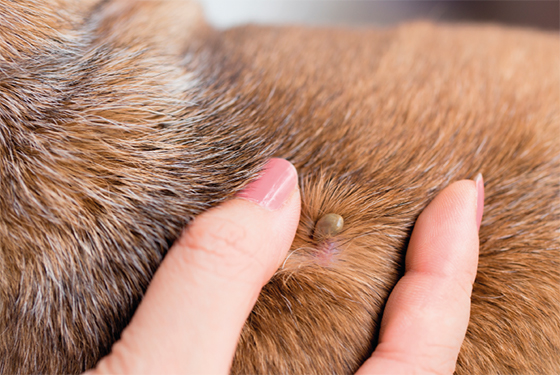Removing ticks from dogs
If you spot a tick on your dog, you should remove it as soon as possible. This will reduce the risk of disease transmission. It is best to use special tick removal tweezers to extract the tick. Here we will explain step by step how you should proceed.
What do ticks look like?
On average, ticks are 3 to 6 millimetres in size. A tick filled with blood, can, however, reach a length of almost three centimetres. At the other end of the spectrum are ticks in their larva stage. Here, the tiny parasites are no larger than the head of a pin and are difficult to spot in a dog’s coat. There are small variations in colour depending on the type of tick. The most common species that attacks dogs is the castor bean tick (Ixodes ricinus), a carrier of, among other things, Lyme disease (Borreliosis). It is black with a brown hind body. The brown dog tick (Rhipicephalus sanguineus), also known as the kennel tick, is uniformly brown, and the ornate dog tick or marsh tick (Dermacentor reticulatus), a carrier of babesiosis, is slightly marbled.

Which ticks are dangerous for dogs?
In principle, every tick can pose a potential danger. No one knows the history of a tick. Ticks extract tiny, completely insignificant amounts of blood from the dog. However, during the process of sucking the blood, a transmission from the tick to the dog of any pathogens present can take place.
From the development of the egg and the larva and nymph stages to the adult creature, these pests usually change their hosts several times. If one of the hosts is carrying a pathogen, the tick can ingest it and may transmit it to another animal at a later stage.
When and where do ticks occur?
Ticks are ectothermic organisms. This means that they cannot control their body temperature themselves, but adapt it to the outside temperature. At temperatures below 6 degrees, they are unable to move. At higher temperatures, however, their bodies slowly come to life. They prefer warm temperatures of around 20 degrees in a fairly shady, humid environment.
They can therefore often be found during spring and autumn in woods and forests, in bushy areas and in tall grass. There they lie in wait for their prey using all their senses. They are able to detect the finest vibrations and can sense both the smell and the CO2 emissions of their victim. If an animal passes by, they simply drop down onto it or quickly claw their way into position on its body.
What helps prevent ticks on dogs?
One of the most important and effective ways to combat ticks is to check your dog’s coat regularly. After a walk in the town this is not usually necessary, but in parks, woods and meadows there is always danger lurking. Luckily, ticks first start looking for a suitable place on the dog’s body.
They prefer areas with thin skin, preferably with good blood circulation and not too much fur. Therefore, if you start looking in time, you will stand a good chance of denying these blood-suckers their feast. This is of course easier with short-haired dogs than with long-haired dogs.
What tick repellent is best for a dog?
There are various ways to protect your dog from a tick bite and its possible consequences, such as contracting Lyme disease, anaplasmosis or babesiosis. Sadly, there is no comprehensive vaccination available, only protection against certain types of Borrelia, which is why there is no general recommendation for vaccination from the Standing Committee on Vaccination in Veterinary Medicine. You should discuss with your vet whether or not a vaccination is worthwhile taking into account the individual epidemic case.
Among the most commonly used remedies against ticks are spot-on products. Here, the liquid solution is simply dripped directly onto the skin at the back of the dog’s neck from where it spreads over its whole body. Spot-ons have a repellent effect and generally prevent a tick from biting your pet. The same applies to tick collars. Here as well, an active ingredient is distributed on the skin, which, depending on the product, offers protection for several months.
Removing a tick from a dog
It is, however, not always possible to entirely rule out finding a tick that has already bitten into the dog and started to suck its blood. Now you have to react quickly and remove the entire tick from the dog. To remove the tick, it is recommended to use special tick removal tweezers or a tick hook.
Important: Do not use oil, nail varnish or glue before removing or in order to remove the tick, as the tick could release further saliva into the wound before it dies, which can contain pathogens.
How to remove ticks effectively
- Move the hair surrounding the tick to the side to avoid pulling out your dog’s hair wherever possible.
- Place the tick removal tweezers as close as possible directly on the dog’s skin.
- As soon as you have a grip on the head or front body, start pulling slowly.
- A twisting action is not usually necessary!
- Gradually pull more strongly and wait.
- The tick will normally come out after a few seconds.
- If not, be patient and enhance the pulling action by twisting gently.
- If the tick has been pulled apart, try to remove the rest with the tick removal tweezers or household tweezers.
- Crush the tick between two solid objects or secure with adhesive tape that you can throw in the rubbish bin.
- If the head of the tick is still in the skin, please observe the area closely and take immediate action if you notice any inflammation.
You may also like this

When a dog keeps scratching itself
Scratching can be an indication of parasites or an allergy

Signs of illness in dogs
Examine your dog regularly for signs of illness

Lyme disease in dogs
Ticks can cause a number of infectious diseases

Fleas in dogs
An infestation of fleas must be treated comprehensively

